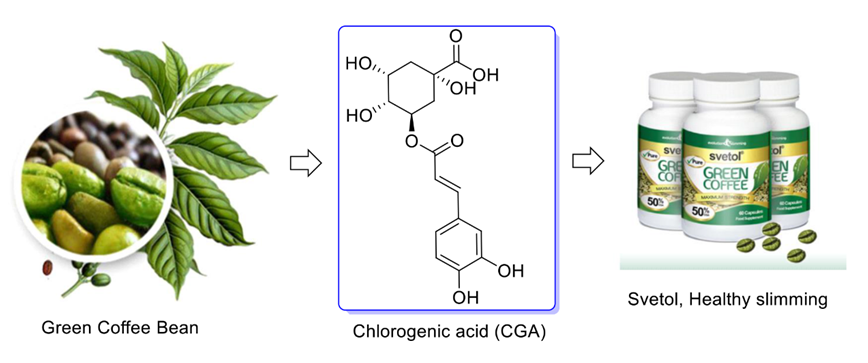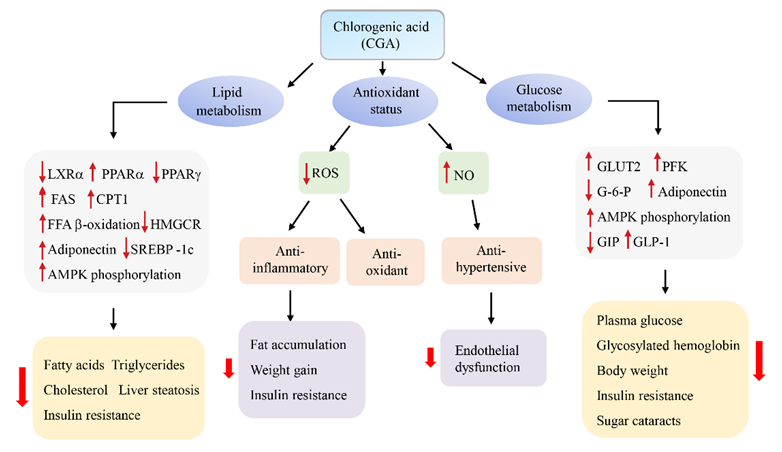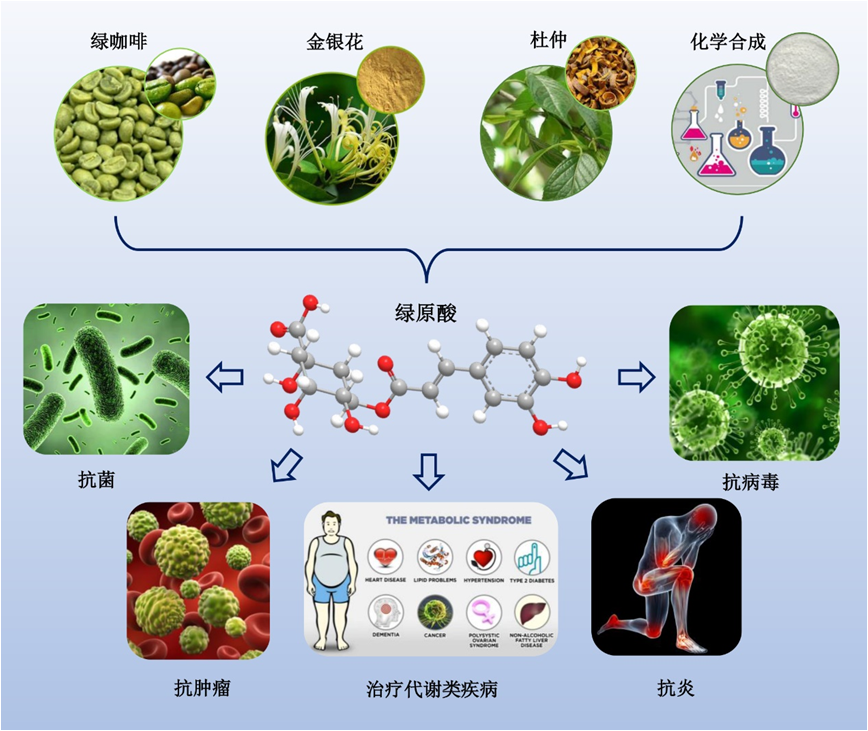
| 绿原酸的药理作用及机制研究进展 | ||||||||||||||||||||||
| [ 来源:四川九章生物科技有限公司 发布日期:2020-05-26 05:45:01 责任编辑: 浏览次 ] | ||||||||||||||||||||||
|
王庆华,杜婷婷,张智慧,季鸣,胡海宇,陈晓光* (中国医学科学院、北京协和医学院药物研究所,中国医学科学院小分子肿瘤免疫治疗药物研究重点实验室,北京100050) 摘要:近年来,对绿原酸(Chlorogenic acid,CGA)的研究发展较快,在医药、化工和食品等领域具有广泛的应用,具有潜在的、广阔的应用前景。其作为一种水溶性酚类化合物,在植物界中广泛分布。具有较强的生物活性和广泛的药理作用。本文拟从抗菌、抗病毒、抗肿瘤、抗氧化和抗炎以及治疗代谢类疾病等几个方面对绿原酸的药理作用及机制作一综述,旨在为绿原酸作用机制的深入研究以及作用靶点的确证提供重要的理论依据。 关键词:绿原酸;药理作用;机制 A pharmacological review and further research of chlorogenic acid Wang Qing-hua, Du Ting-ting, Zhang Zhi-hui, Ji Ming, Hu Hai-yu, Chen Xiao-guang* (State Key Laboratory of Small Molecular Tumor Immunotherapy Drug Research, Chinese Academy of Medical Sciences, Institute of Materia Medica, Chinese Academy of Medical Sciences and Peking Union Medical College, Beijing 100050, China) Abstract: In recent years, the research on chlorogenic acid (CGA) has developed rapidly, and has a wide range of applications in the fields of medicine, chemical industry and food. It has potential and broad application prospects. As a water-soluble phenolic compound, it is widely distributed in the plant kingdom. It has strong biological activity and a wide range of pharmacological effects. This article intends to review the pharmacological effects and mechanisms of chlorogenic acid from several aspects such as antibacterial, antiviral, antitumor, antioxidant and anti-inflammatory and treatment of metabolic diseases. The purpose is to provide important theoretical basis for the in-depth research on the mechanism of chlorogenic acid and confirming the action target. Key words: chlorogenic acid; pharmacological action; mechanism 基金项目:重大新药创制科技重大专项( 2016ZX09101017);创新工程-重大协同创新项目(2019-I2M-1-005);中国医学科学院医学与健康科技创新工程(2017-I2M-2-004);北京协和医学院研究生创新基金(2019-1007-13). 通讯作者Tel: 86-10-63165207, E-mail: chxg@imm.ac.cn 绿原酸是由咖啡酸的羧基和奎尼酸的羟基缩合成缩酚酸,是植物细胞通过莽草酸途径合成的一种苯丙素类物质,其分子结构中有酯键、不饱和双键、多元酚和邻二酚羟基[1, 2]。绿原酸在杜仲、金银花、绿咖啡豆、土豆、苹果以及茶叶等多种植物中含量很高[3-5]。具有抗氧化、抗菌、抗病毒、抗肿瘤、降血脂、降血糖和免疫调节等多方面的药理作用[6-8],在食品、医药和化工等领域都有广泛的应用[9](图 1)。随着科技的进步和研究的深入,绿原酸药理作用机制逐渐被重视。现对绿原酸的药理作用和作用机制进行综述,以期为绿原酸的药用研究与开发提供参考。
Figure 1 The application of chlorogenic acid from green coffee beans in weight loss 1 绿原酸的药理作用及机制 1.1 抗菌 大量研究证明,绿原酸具有广谱抗真菌和细菌的作用[7]。Martíne等[10]在2017年报道了绿原酸对多种植物致病真菌有抗真菌活性,具有生物杀真菌剂的潜力,其机制是通过抑制真菌孢子的早期透膜化来控制不同的植物病原真菌的生长。已有大量文献报道,绿原酸是通过破坏肺炎链球菌(Streptococcus pneumoniae),金黄色葡萄球菌(Staphylococcus aureus)和痢疾志贺氏菌(Shigella dysenteriae)的细胞膜,增加外膜和质膜通透性, 导致细菌的屏障功能丧失,进而发挥其抗菌活性[11, 12]。Ren等[13]通过将绿原酸包被到聚二甲基硅氧烷(硅油)表面上起到对硅油的消毒作用,其抗菌作用的新机理是通过降低细菌细胞壁的硬度,减慢细菌的迁移和影响细菌细胞膜的稳定性。Lee课题组[14]则阐明了绿原酸抑菌作用的机制是通过诱导活性氧耗竭进而引发大肠杆菌的类凋亡死亡。综上所述,随着绿原酸的抗菌机制深入研究为新型抗生素的研发奠定了坚实的基础。 1.2 抗病毒 很多文献报道,绿原酸及其衍生物作为天然化合物,对多种不同类型的病毒有很好的抑制作用,其中包括艾滋病病毒(Human immunodeficiency virus,HIV),甲型流感病毒(H1N1/H3N2),单纯疱疹病毒(Herpes simplex virus, HSVs),乙型肝炎病毒(Hepatitis B virus,HBV)等[15, 16]。1997年,Robinson等[17]报道了绿原酸可以抑制HIV-1整合酶。Tamura等[18]于2006年在人淋巴瘤细胞株MT-2上验证了绿原酸可以有效地抑制HIV病毒,为HIV的新药设计提供新的先导化合物。Nikolai课题组[19]在2016年首次报道了绿原酸及其衍生物具有抑制病毒的神经氨酸酶活性。Ding等[20]也证明绿原酸在感染的后期可有效抑制甲型流感病毒(H1N1/H3N2)的感染。通过间接免疫荧光分析表明其下调了病毒核蛋白 (Nucleoprotein,NP)的表达,并在细胞水平和动物水平上证明绿原酸通过抑制神经氨酸酶活性来抑制病毒感染。Zhao课题组[21]证明了加入绿原酸可以显著提高HSV-1感染的小胶质细胞(BV2)的存活率,同时抑制了感染细胞中TLR2 (Toll样受体,Toll-like receptor,TLR)、TLR9和髓样分化因子(Myeloid differentiation factor88,Myd88)的增加和降低了炎症因子肿瘤坏死因子-α(Tumor necrosis factor-α,TNF-α)和IL -6(白细胞介素,Interleukin,IL)释放。因此,证明了绿原酸可以通过有效地抑制病毒感染产生和炎症反应来治疗病毒感染。2009年,Wang等[22]以HepG2.2.15细胞和鸭乙型肝炎病毒感染模型证明了绿原酸可以抑制HBV-DNA复制以及乙型肝炎表面蛋白抗原(Hepatitis B surface antigen,HBsAg)的产生。由此可见,绿原酸有望成为一个潜在的广谱抗病毒药物。 1.3 抗肿瘤 20世纪80年代,绿原酸被发现具有抑制肿瘤的作用,从而引起了人们的广泛关注[23]。此后,有关其抑制不同类型肿瘤和机制研究越来越多。2017年我们课题组首次报道了绿原酸通过影响巨噬细胞的M1/M2极化分型(即促进M1型巨噬细胞和抑制M2表型巨噬细胞)进而抑制脑胶质瘤生长[24]。Jiang课题组[25]报道了绿原酸对肝癌、肺癌和胶质瘤都有明显抑制作用,其机制不是通过直接的杀伤作用而是通过影响肿瘤细胞诱导分化来抑制肿瘤,并指出绿原酸有望成为一种安全有效的肿瘤分化诱导剂。Hou等[26]研究发现绿原酸通过诱导活性氧的产生进而抑制结肠癌。Sapio等[27]报道绿原酸通过激活细胞外信号调节激酶1/2(Extracellular regulated protein kinases,ERK1/2)抑制骨肉瘤细胞的增殖。Motoki Tagami课题组[28]报道了绿原酸通过影响细胞凋亡相关基因的表达起到抑制肺癌细胞的作用。尽管大量文献报道了绿原酸抗肿瘤作用机制,但看法不尽一致。因此,潜在靶点的寻找和作用的机制有待进一步探索。 1.4 抗氧化和抗炎 绿原酸是一种广泛存在植物中的多酚类次生代谢产物,具有很强抗氧化和抗炎特性。儿茶酚结构的存在为自由基提供了结合位点[29, 30],绿原酸能够螯合金属离子和清除自由基 (超氧阴离子(O2-),过氧化氢(H2O2),羟基自由基(•OH),次氯酸(HOCl),过氧亚硝酸盐阴离子(ONOO-)和一氧化氮(NO)) [31-33]。 Lu等[34]报道了绿原酸表现出很强的抗氧化活性,其清除DPPH自由基的活性是维生素C和E的2-3倍和清除超氧阴离子自由基的活性是维生素C和E的10-30倍。近年来,绿原酸的抗炎作用也备受关注。2006年,Dos Santos等[35]在脂多糖诱导大鼠炎症模型上首次报道了绿原酸具有抗炎活性。随后,有很多文献对其抗炎机制进行了深入地探讨。2018年,Hee等[36]发现绿原酸可以抑制氧化应激诱导的肠上皮细胞中IL-8的产生来起到抗炎作用,并阐明了其作用机制是通过清除细胞内活性氧(Reactive oxygen species,ROS)进而通过蛋白激酶D-核因子κB(Protein kinase D -Nuclear factor kappa-B,PKD-NF-κB)信号通路的激活抑制IL-8的产生。同年,Liang等[37]也指出绿原酸及其异构体可以通过抑制p38级联磷酸化和上调NF-κB信号通路来抑制其上皮细胞(Caco-2)中IL-8产生。Gao等[38]在硫酸葡聚糖诱导的小鼠溃疡性结肠炎模型中,发现绿原酸是通过调控丝裂原活化蛋白激酶(Mitogen-activated protein kinase,MAPK)/ERK/c-Jun氨基末端激酶(c-Jun N-terminal kinase,JNK)信号通路来降低组织的炎症反应。Fu等[39]实验证明绿原酸有望成为治疗类风湿关节炎(Rheumatoid arthritis,RA)的新型治疗剂,其机制是通过降低了NF-κB与B细胞活化因子(B cell-activating factor,BAFF)启动子区域的DNA结合能力,并抑制了TNF-α刺激的MH7A细胞中NF-κB途径的BAFF表达。Shi等[40]证明绿原酸可以有效降低CCl4诱导的急性肝损伤产生TNF-α,IL-6和IL-1β炎症因子,其机制是通过活化核因子类红细胞2相关因子2(Nuclear factor erythroid 2-related factor 2,Nrf2)信号通路并抑制核苷酸结合寡聚结构域,富含亮氨酸重复序列和含Pyrin结构域3(Nucleotide- binding oligomerization domain, leucine- rich repeat and pyrin domain- containing 3,NLRP3)炎症小体激活来进行急性肝损伤的保护作用。Tsai等[41]在用绿原酸预处理的情况下,用氧化型低密度脂蛋白(Human Ox-LDL,oxLDL) 处理HUVEC细胞。结果表明,绿原酸预处理可提高NAD-依赖性去乙酰化酶(Sirtuin 1,SIRT1)活性水平,逆转了oxLDL受损的SIRT1和AMP激活的蛋白激酶(AMP-activated protein kinase,AMPK)/过氧化物酶体增殖物受体γ共激活因子1(Peroxisome proliferator-activated receptor-gamma coactivator-1,PGC-1)活性,并减轻了oxLDL诱导的氧化应激和线粒体生物发生功能障碍。其机制通过调节SIRT1和AMPK / PGC-1功能来抑制oxLDL诱导的内皮细胞凋亡。因此,使沉默SIRT1,AMPK和PGC-1会减弱绿原酸抵御氧化应激的能力。Yang等[42]报道了绿原酸通过激活SIRT1调节的线粒体形态来预防饱和游离脂肪酸(Free fatty acid,FFA)诱导的脂毒性。结果表明。绿原酸通过减少ROS的产生以及增加线粒体质量和线粒体膜电位,减轻了氧化应激和线粒体功能障碍;显著降低促细胞凋亡蛋白Bax(Bcl2 associated X,Bax)表达,从而减少线粒体介导的caspase依赖性细胞凋亡。在机制上,通过抑制动力蛋白相关蛋白1(Dynamin-relatedprotein1,Drp1)和增强线粒体融合蛋白 2(Mitofusin 2,Mfn2)表达来减弱ROS诱导的线粒体片段化;激活SIRT1阻止了绿原酸对线粒体ROS和Drp1的抑制作用。Ali等[43]研究表明绿原酸具有肝保护作用,其机制通过增加抑制细胞凋亡Bcl2(B淋巴细胞瘤-2,B-cell lymphoma-2,Bcl2)表达并抑制环氧化酶-2(Cyclooxygenase-2,Cox-2)、诱导型一氧化氮合酶(Inducible nitric oxide synthase,iNOS)、Bax和Caspases 3、9介导的炎症反应和细胞凋亡来降低甲氨蝶呤(Methotrexate,MTX)诱导的肝毒性。Wang等[44]研究表明绿原酸通过影响肝星状LX2细胞系中IL-13/microRNA-21(miR-21)/Smad7信号传导相互作用抑制血吸虫病诱导的肝纤维化,因此,绿原酸有望成为用于治疗血吸虫病肝纤维化的抗肝纤维化类药物。神经退行性疾病(阿尔茨海默氏病(Alzheimer disease,AD)和帕金森氏病(Parkinson’s disease,PD))的病理学研究表明慢性氧化应激和促炎机制会导致神经元受损[45]。基于绿原酸具有较强的抗氧化和抗炎作用,很多学者发现它具有很好神经系统保护作用[46]。在一些临床和临床前研究表明咖啡提取物(主要成分绿原酸)对AD和PD展现出很好的效果[47, 48]。Hermawati等[49]发现绿原酸可以改善记忆力减退和海马细胞短暂性全脑缺血后死亡,其机制是通过增加Bcl2、超氧化物歧化酶2(Superoxide dismutase 2,SOD2)和血小板-内皮细胞粘附分子CD31(Platelet endothelial cell adhesion molecule-1,PECAM-1/CD31)表达并降低内皮素(Endothelin-1,ET-1)表达来改善空间记忆并防止双侧颈总动脉闭塞后CA1锥体细胞死亡。Fang课题组[50]研究表明,绿原酸作为一种有效的自由基清除剂,可以显著保护PC12细胞免受氧化损伤。其机制包括直接的ROS猝灭活性和通过激活Nrf2诱导内源性抗氧化酶。因此,绿原酸可以作为潜在的神经保护药物。 1.5 治疗代谢性疾病 随着社会的进步和人类物质生活水平的提高,代谢相关性疾病已成为全球影响人类健康的重要问题。其中包括血脂异常、高血压、高空腹血糖水平、胰岛素抵抗、慢性炎证和血栓形成等[51]。随着天然产物在治疗代谢性疾病优势的逐渐展现,人们又重新燃起了对天然产物的兴趣。许多研究已经评估绿原酸对代谢类疾病的影响,其中包括肥胖、血脂异常、糖尿病、高血压、代谢综合征和保护心血管等[52]。 在治疗肥胖方面,Wang等[53]喂食高脂饮食(High fat diet,HFD)小鼠用绿原酸治疗6周。结果表明,给予绿原酸可显著降低小鼠的体重,降低血浆中的脂质水平,并改变脂肪组织中脂肪生成和脂肪分解相关基因的mRNA表达。 此外,绿原酸改善HFD诱发的肠道菌群失调,也有助于改善HFD诱发的肥胖。Han等[54] 研究表明绿原酸通过促进葡萄糖的摄取和线粒体的功能来刺激褐色脂肪细胞的生热。其机制增强了棕色脂肪细胞的生热和质子泄漏,上调了葡萄糖转运蛋白2(Glucose transporter type 2,GLUT2)和磷酸果糖激酶(Phosphofructokinase,PFK)来促进葡萄糖的吸收,增加了线粒体的数量和功能。2019年,Xu等[55]研究了绿原酸和咖啡因对高脂饮食诱导的肥胖小鼠脂质代谢的联合作用机理。饲喂绿原酸和咖啡因的联合使用可有效降低增加的体重、腹膜内脂肪组织重量、血清LDL-c、FFA、总胆固醇(Totalcholesterol,TC)、三酸甘油脂 (Triglyceride,TG)、瘦素、IL-6浓度以及肝TG和TC水平,并增加血清脂联素水平,促进了AMPKα的磷酸化,抑制了转录调节因子固醇调节元件结合蛋白-1c(Sterol regulatory element-binding protein-1c,SREBP-1c)和肝X受体α(Liver X receptor α,LXRα)的表达,并降低了脂肪酸合成(Fatty acid synthesis,FAS)和3-羟基3-甲基戊二酰辅酶A还原酶(HMG-CoA Reductase,HMGR)的表达。此外,增加了脂肪组织甘油三酯水解酶(Adipose triglyceride lipase,ATGL)和激素敏感脂肪酶(Hormone-sensitive lipase,HSL)的表达。结果表明,绿原酸和咖啡因的联用,可以激活AMPKα-LXRα/ SREBP-1c信号通路对高脂饮食诱导的肥胖小鼠具有抗肥胖作用和调节脂质代谢。同年Kumar等[56]也报道了绿原酸通过激活AMPK,抑制HMGR,增强肉碱棕榈酰转移酶 (Carnitine palmitoyltransferase 1,CPT1) 的活性控制肥胖。Cho等[57]研究了绿原酸对高脂饮食诱导肥胖小鼠的体重、体脂和肥胖相关激素的影响。与高脂饮食对照组相比,绿原酸和咖啡酸均显著降低体重、内脏脂肪量、血浆瘦素和胰岛素水平、肝脏和心脏中的甘油三酸酯以及脂肪组织和心脏中的胆固醇。Huang等[58]在大鼠实验中获得了相似的结果,绿原酸以剂量依赖性方式抑制体内和内脏脂肪的增加和高脂饮食诱导的游离脂肪酸。同样人体研究也显示富含绿原酸的食物具有抗肥胖作用。Thom[59]给予30名超重受试者12周,每天五杯普通速溶咖啡或Coffee Slender®(富含绿原酸)。喝Coffee Slender®参与者明显减少了体重,其中80 %的减少是体内脂肪,而普通速溶咖啡的参与者减少体重和体内脂肪的作用并不显著。此外,Soga等[60]研究了绿原酸对人体能量代谢的影响。18名健康男性受试者每天食用185 ml含或不含绿原酸的测试饮料(329 mg),持续4周,间接量热法显示与对照饮料相比含有绿原酸的饮料可显著提高餐后能量的利用,并且饮用含绿原酸饮料的受试者餐后脂肪利用率更高。 在控制血脂异常方面,Cho等[57]观察到绿原酸和咖啡酸均显著降低小鼠血浆中的游离脂肪酸、甘油三酸酯和胆固醇,与高脂对照组相比显著提高了高密度脂蛋白胆固醇/总胆固醇的比率。Huang等[58]发现绿原酸以剂量依赖性方式抑制高脂饮食诱导的血清脂质水平。Wan等[61]研究了绿原酸对大鼠高胆固醇血症的影响。发现绿原酸可显著降低总胆固醇和低密度脂蛋白胆固醇,并增加高密度脂蛋白胆固醇;此外,还改善了动脉粥样硬化指数和心脏危险因素。 在治疗糖尿病方面,Ong等[62]观察到绿原酸抑制Leprdb/db糖尿病小鼠的肝中葡萄糖6-磷酸酶(Glucose-6-phosphatase,G-6-P)表达和活性,减少肝脂肪变性,改善脂质分布和骨骼肌葡萄糖摄取,从而改善空腹血糖水平、葡萄糖耐量、胰岛素敏感性和血脂异常。Attila等[63]研究了白桑树的叶提取物及其三种主要成分(绿原酸、芦丁和异槲皮素)的抗糖尿病活性。在链脲霉素诱导糖尿病大鼠模型,发现白桑树的叶提取物、绿原酸和芦丁的非空腹血糖水平呈剂量依赖性降低,而异槲皮素则未见。Jin等[64]研究了绿原酸对晚期糖尿病小鼠葡萄糖和脂质代谢的影响。与对照组相比,绿原酸组的体脂,空腹血糖和糖基化血红蛋白(Hemoglobin A1c,HbA1c)百分比显着降低。Kim等[65]通过大鼠半乳糖性白内障模型来确定绿原酸对糖性白内障的影响。实验显示,持续两周口服绿原酸可以有效阻止糖性白内障的发展。Bagdas等[66]研究了绿原酸治疗对大鼠糖尿病伤口愈合的影响,使用链脲霉素诱导糖尿病大鼠模型并在其背部形成伤口,通过观察伤口愈合的时间,发现绿原酸加速伤口愈合。Johnston等[67]评估了咖啡中绿原酸抗糖尿病作用。实验结果表明绿原酸可以显著降低葡萄糖依赖性促胰岛素多肽(Glucose-dependent insulinotropic polypeptide,GIP),显著增加胰高血糖素样肽1(Glucagon-like peptide-1,GLP-1)的分泌,结果显示,绿原酸有效降低肠道葡萄糖吸收率,对葡萄糖转运具有拮抗作用。同样Iwai等[68]通过对45位受试者评估了富含绿原酸的不含咖啡因的绿咖啡豆提取物的降血糖作用。发现摄入含有绿原酸饮料后血浆葡萄糖显着降低,但未观察到血浆胰岛素谱有显著变化。Ahrens[69]研究了Emulin™(绿原酸,杨梅素和槲皮素的专利混合物)的抗糖尿病作用。对40位2型糖尿病患者进行治疗。结果显示,如果定期食用EmulinTM,不仅具有降低食物血糖的急性作用,而且可以长期降低2型糖尿病患者的血糖水平。基于绿原酸对人体的糖代谢障碍具有调节作用,Gao等[70]通过绿原酸修饰的功能化磁微球蛋白寻找了绿原酸的靶点为蛋白激酶B(Protein kinase B,AKT)。并通过绿原酸分子探针的免疫荧光进一步证明了绿原酸与AKT的共定位。同时阐明了其作用机制是通过直接靶向AKT的PH结构域,激活AKT在Ser-473上的磷酸化,诱导下游分子的磷酸化,糖原合酶激酶3(Glycogen synthase kinase 3, GSK3)和叉头框转录因子O亚族1(Forkhead box O1, FOXO1),从而发挥葡萄糖代谢调节作用。 在治疗代谢综合征方面,Ma等[71]研究评估绿原酸在代谢综合征中的作用时发现绿原酸的预防和治疗对肥胖症及与肥胖有关的小鼠肝脏脂肪变性和胰岛素抵抗有很好的疗效。绿原酸有效防止体重增加,抑制肝脂肪变性的发展,并减低高脂饮食诱导的胰岛素抵抗。Patti等[52]评价了一个含有绿原酸的天然补品对代谢综合征患者的影响。78名患有代谢综合征的患者持续服用4个月,其体重、体重指数、腰围、空腹血糖和体重显着降低,也观察到总胆固醇也得到有效地降低。 在治疗心血管系统和血栓栓塞性疾病方面,绿原酸显现出很好的疗效,在细胞水平,Sancheza等[72]研究表明用200 mM 绿原酸处理3T3-L1脂肪细胞后,细胞内钙浓度相对于对照增加了9倍,同时也促进了胰岛素的分泌,同时显著提高了PPARg (过氧化物酶体增殖剂激活受体,Peroxisome proliferator-activated receptor,PPAR)(150 %)和GLUT4(220 %)以及PPARa(40 %)和脂肪酸转运蛋白(Fatty acid transporters,FATP)(25 %)的mRNA表达。因此,可作为刺激胰岛素的增敏剂和降脂剂。在整体动物,Suzuki等[73]报道了绿原酸对减低自发性高血压大鼠的血压和改善血管功能。其机制通过抑制血管系统中活性氧过量的产生来降低氧化应激和提高一氧化氮的生物利用度,进而减轻了自发性高血压大鼠的内皮功能障碍,血管肥大和高血压。在人体,纯绿原酸和绿原酸含量很高食物可以对血压产生积极影响。Kozuma等[74]针对117名轻度的高血压健康男性。分组给予28天了不同浓度绿原酸,发现绿原酸可以有效降低收缩压(Systolic blood pressure,SBP)和舒张压(Diastolic blood pressure,DBP),其原因绿原酸具有抗氧化特性,改善内皮功能障碍并降低血压。Watanabe等[75]也同样证明了绿原酸有效降低患有高血压患者的血压。Mubarak等[76]研究了绿原酸对一氧化氮状态、内皮功能和血压的急性影响。结果显示,给予绿原酸的受试者的收缩压和舒张压均明显降低,一氧化氮的状态和内皮功能未受到明显影响。绿原酸可用于预防糖尿病引发的心血管系统损害[77]。Stefanello等[78]研究表明绿原酸作为抗凝剂,当糖尿病大鼠的血小板在激动剂二磷酸腺苷(Adenosine diphosphate,ADP)刺激下,绿原酸治疗30天血小板聚集可明显减少。此外,Fuentes等[79]证明绿原酸抑制血小板A2A受体/腺苷酸环化酶/环磷酸腺苷(Cyclic adenosine phosphate,cAMP)/ 蛋白激酶A(Protein kinase A,PKA)信号激活途径进而抑制小鼠动脉血栓形成。综述所述,现对绿原酸治疗代谢性疾病的作用机制进行总结(图 2)。
Figure 2 Mechanisms of action of chlorogenic acid over metabolic diseases. Abbreviations: AMPK = AMP-activated protein kinase, CPT1 = Carnitine palmitoyltransferase 1, FAS = Fatty acid synthase, FFA = Free fatty acid, GLUT2=Glucose transporter type 2, G-6-P = Glucose-6-phosphatase, GIP = Glucose-dependent insulinotropic polypeptide, GLP-1=Glucagon-like peptide-1, HMGCR = 3-hydroxy-3-methylglutaryl CoA reductase, LXR = Liver X receptor, NO = Nitric oxide, PFK = Phosphofructokinase, PPAR = Peroxisome proliferator-activated receptor, ROS = Reactive oxygen species, SREBP-1c = Sterol regulatory element-binding protein 1c 2 总结 近年来,有关绿原酸的研究报道越来越多,业已成为天然产物领域研究热点之一。绿原酸作为金银花、杜仲、咖啡、茵陈等许多中草药的主要有效成分之一,随着其生物活性的不断深入研究,它的应用愈加广泛。在国外已将绿原酸作为减肥的保健品出售。在我们国家,绿原酸也作为抗肿瘤药物进行晚期复发脑胶质母细胞瘤的II期临床研究。但值得注意地是, 虽然我国对含有绿原酸及其衍生物的中药的使用有着悠久的历史, 但是我们对绿原酸分子机制的探索和靶点验证仍然存在很大的不足, 这也是我们今后着力解决的问题。 References [1] Kühnl T, Koch U, Heller W, et al. Chlorogenic acid biosynthesis: characterization of a light-induced microsomal 5-O-(4-coumaroyl)-D-quinate/shikimate 3'-hydroxylase from carrot (Daucus carota L.) cell suspension cultures [J]. Arch Biochem Biophys, 1987, 258(1): 226-232. [2] Lallemand L A, Zubieta C, Lee S G, et al. A structural basis for the biosynthesis of the major chlorogenic acids found in coffee [J]. Plant Physiol, 2012, 160(1):249-260. [3] Lepelley M, Cheminade G, Tremillon N, et al. Chlorogenic acid synthesis in coffee: An analysis of CGA content and real-time RT-PCR expression of HCT, HQT, C3H1, and CCoAOMT1 genes during grain development in C. canephora [J]. Plant Sci, 2007, 172(5): 978-996. [4] Duarte G S, Pereira A A, Farah A. Chlorogenic acids and other relevant compounds in Brazilian coffees processed by semi-dry and wet post-harvesting methods [J]. Food Chem, 2010, 118(3):851-855. [5] Wang Z, Clifford M N. Comparison of the profiles of chlorogenic acids and their derivatives from three Chinese traditional herbs by LC-MSn [J]. Acta Pharm Sin, 2008, 43(2):185-190. [6] Naveed M, Hejazi V, Abbas M, et al. Chlorogenic acid (CGA): A pharmacological review and call for further research [J]. Biomed Pharmacother, 2018, 97:67-74. [7] Bagdas D, Gul Z, Meade J A, et al. Pharmacologic Overview of Chlorogenic Acid and its Metabolites in Chronic Pain and Inflammation [J]. Curr Neuropharmacol, 2020, 18(3):216-228. [8] Li Y, Wang Q, Yao X, et al. Induction of CYP3A4 and MDR1 gene expression by baicalin, baicalein, chlorogenic acid, and ginsenoside Rf through constitutive androstane receptor- and pregnane X receptor-mediated pathways [J]. Eur J Pharmacol, 2010, 640(1-3):46-54. [9] Santana-Gálvez Jesús, Luis C Z, Jacobo-Velázquez Daniel. Chlorogenic acid: recent advances on its dual role as a food additive and a nutraceutical against metabolic syndrome [J]. Molecules, 2017, 22(3):358. [10] Martínez G, Regente M, Jacobi S, et al. Chlorogenic acid is a fungicide active against phytopathogenic fungi [J]. Pestic Biochem Physiol, 2017, 140:30-35. [11] Lou Z, Wang H, Zhu S, et al. Antibacterial activity and mechanism of action of chlorogenic acid [J]. J Food Sci, 2011, 76:M398-M403. [12] Li G, Wang X, Xu Y, et al. Antimicrobial effect and mode of action of chlorogenic acid on Staphylococcus aureus [J]. Eur Food Res Technol, 2014, 238:589-596. [13] Ren S, Wu M, Guo J, et al. Sterilization of polydimethylsiloxane surface with Chinese herb extract: a new antibiotic mechanism of chlorogenic acid [J]. Sci Rep, 2015, 5:10464. [14] Lee B, Lee D G. Depletion of reactive oxygen species induced by chlorogenic acid triggers apoptosis-like death in Escherichia coli [J]. Free Radic Res, 2018, 52(5):1-11. [15] Neamati N, Hong H, Sunder S, et al. Potent inhibitors of human Immunodeficiency virus type 1 integrase: identification of a novel four-point pharmacophore and tetracyclines as novel inhibitors [J]. Mol Pharmacol, 1997, 52(6):1041. [16] Utsunomiya H, Ichinose M, Uozaki M, et al. Antiviral activities of coffee extracts in vitro [J]. Food Chem Toxicol, 2008, 46(6):1919-1924. [17] Robinson W E, Cordeiro M, Abdel-Malek S, et al. Dicaffeoylquinic acid inhibitors of human immunodeficiency virus integrase: Inhibition of the core catalytic domain of human immunodeficiency virus integrase [J]. Mol Pharmacol, 1996, 50(4):846-855. [18] Tamura H, Akioka T, Ueno K, et al. Anti-human immunodeficiency virus activity of 3,4,5-tricaffeoylquinic acid in cultured cells of lettuce leaves [J]. Mol Nutr Food Res, 2006, 50(4-5): 396-400. [19] Karar M G E, Matei M F, Jaiswal R, et al. Neuraminidase inhibition of dietary chlorogenic acids and derivatives-potential antivirals from dietary sources [J]. Food Funct, 2016, 7: 2052-2059. [20] Ding Y, Cao Z, Cao L, et al. Antiviral activity of chlorogenic acid against influenza A (H1N1/H3N2) virus and its inhibition of neuraminidase [J]. Sci Rep, 2017, 7:45723. [21] Guo Y J, Luo T, Wu F, et al. Involvement of TLR2 and TLR9 in the anti-inflammatory effects of chlorogenic acid in HSV-1-infected microglia [J]. Life Sciences, 2015, 127:12-18. [22] Wang G F, Shi L P, Ren Y D, et al. Anti-hepatitis B virus activity of chlorogenic acid, quinic acid and caffeic acid in vivo and in vitro [J]. Antiviral Res, 2009, 83(2):186-190. [23] Huang M T, Smart R C, Wong C Q, et al. Inhibitory effect of curcumin, chlorogenic acid, caffeic acid, and ferulic acid on tumor promotion in mouse skin by 12-O-tetradecanoylphorbol-13-acetate[J]. Cancer Res. 1988, 48(21):5941-5946. [24] Xue N, Zhou Q, Ji M, et al. Chlorogenic acid inhibits glioblastoma growth through repolarizating macrophage from M2 to M1 phenotype [J]. Sci Rep, 2017, 7:39011. [25] Huang S, Wang L L, Xue N N, et al. Chlorogenic acid effectively treats cancers through induction of cancer cell differentiation [J]. Theranostics. 2019, 9(23): 6745-6763. [26] Hou N, Liu N, Han J, et al. Chlorogenic acid induces reactive oxygen species generation and inhibits the viability of human colon cancer cells [J]. Anti-Cancer Drugs, 2016, 28(1):1. [27] Sapio L, Salzillo A, Illiano M, et al. Chlorogenic acid activates ERK1/2 and inhibits proliferation of osteosarcoma cells [J]. J Cell Physiol. 2020, 235:3741-3752. [28] Yamagata K, Izawa Y, Onodera D, et al. Chlorogenic acid regulates apoptosis and stem cell marker-related gene expression in A549 human lung cancer cells [J]. Mol and Cell Biochem, 2018, 441: 9-19. [29] Kono Y, Kobayashi K, Tagawa S, et al. Antioxidant activity of polyphenolics in diets. Rate constants of reactions of chlorogenic acid and caffeic acid with reactive species of oxygen and nitrogen [J]. Biochim Biophys Acta, 1997, 1335(3): 335-342. [30] Riceevans C A, Miller N J, Paganga G. Structure-antioxidant activity relationships of flavonoids and phenolic acids [J]. Free Radic Biol Med, 1996, 20(7): 933-956. [31] Sato, Y, Itagaki, S, Kurokawa, T, et al. In vitro and in vivo antioxidant properties of chlorogenic acid and caeic acid [J]. Int J Pharm, 2011, 403: 136-138. [32] Kono Y, Kobayashi K, Tagawa S, et al. Antioxidant activity of polyphenolics in diets. Rate constants of reactions of chlorogenic acid and caffeic acid with reactive species of oxygen and nitrogen [J]. Biochim Biophys Acta, 1997, 1335(3): 335. [33] Zhang L Y, Cosma G, Gardner H, et al. Effect of chlorogenic acid on hydroxyl radical [J]. Mol Cell Biochem, 2003, 247: 205–210. [34] Lu Y, Foo L Y. Antioxidant and radical scavenging activities of polyphenols from apple pomace [J]. Food Chem, 68(1): p81-85. [35] Dos Santos M D, Almeida M C, Lopes N P, et al. Evaluation of the Anti-inflammatory, Analgesic and Antipyretic Activities of the Natural Polyphenol Chlorogenic Acid [J]. Biol Pharm Bull, 2006, 29(11): 2236-2240. [36] Hee S, Hideo S, Min-Jung B, et al. Catechol groups enable reactive oxygen species scavenging-mediated suppression of PKD-NFkappaB-IL-8 signaling pathway by chlorogenic and caffeic acids in human intestinal cells [J]. Nutrients, 2017, 9(2): 165. [37] Liang N, D. Kitts D. Chlorogenic acid (CGA) isomers alleviate interleukin 8 (IL-8) production in Caco-2 cells by decreasing phosphorylation of p38 and increasing cell integrity[J]. Int J Mol Sci, 2018, 19: 3873. [38] Gao W, Wang C, Yu L, et al. Chlorogenic Acid Attenuates Dextran Sodium Sulfate-Induced Ulcerative Colitis in Mice through MAPK/ERK/JNK Pathway [J]. BioMed Res Internat, 2019, 6769789. [39] Fu X, Lyu X, Liu H, et al. Chlorogenic acid inhibits BAFF expression in collagen-induced arthritis and human synoviocyte MH7A cells by modulating the activation of the NF-κB signaling pathway [J]. J Immunol Res, 2019, 8042097. [40] Shi A, Shi H, Wang Y, et al. Activation of Nrf2 pathway and inhibition of NLRP3 inflammasome activation contribute to the protective effect of chlorogenic acid on acute liver injury [J]. Int Immunopharmacol, 2018, 54:125-130. [41] Tsai K L, Hung C H, Chan S H, et al. Chlorogenic acid protects against oxLDL-induced oxidative damage and mitochondrial dysfunction by modulating SIRT1 in endothelial cells [J]. Mol Nutr Food Res, 2018, 1700928. [42] Yang L, Wei J, Sheng F, et al. Attenuation of palmitic acid-Induced lipotoxicity by chlorogenic acid through activation of SIRT1 in hepatocytes [J]. Mol Nutr Food Res, 2019, 63 (14): 1801432. [43] Ali N, Rashid S, Nafees S, et al. Protective effect of chlorogenic acid against methotrexate induced oxidative stress inflammation and apoptosis in rat liver: An experimental approach [J]. Chem Biol Interact, 2017, 272: 80-91. [44] Wang Y, Yang A F, Xue B J, et al. Antischistosomiasis liver fibrosis effects of chlorogenic acid through IL-13/miR-21/Smad7 signaling interactions in vivo and in vitro [J]. Antimicrob Agents Chemother, 2016, 61(2): e01347-16. [45] Nabavi S M, Manayi A, Daglia M, et al. Chlorogenic acid and mental diseases: from chemistry to medicine [J]. Curr Neuropharmacol, 2017, 15(4): 471-479. [46] Lin M T, Beal M F. Mitochondrial dysfunction and oxidative stress in neurodegenerative diseases [J]. Nature, 2006, 443(7113): 787-795. [47] Ascherio A, Chen H, Schwarzschild M A, et al. Caffeine, postmenopausal estrogen, and risk of Parkinsons disease. Neurology, 2003, 60(5), 790-795. [48] Arendash G W, Schleif W, Rezai-Zadeh K, et al. Caffeine protects Alzheimer's mice against cognitive impairment and reduces brain beta-amyloid production [J]. Neuroscience, 2006, 142(4): 941-952. [49] Hermawati E, Arfian N, Mustofa, et al. Chlorogenic acid ameliorates memory loss and hippocampal cell death after transient global ischemia [J]. Eur J Neurosci, 2020, 51: 651–669. [50] Juan Y, Peng S, Xu J, et al. Reversing ROS-mediated neurotoxicity by chlorogenic acid involves its direct antioxidant activity and activation of Nrf2-ARE signaling pathway [J]. Biofactors, 2019, 45(4):616-626. [51] Gregory K, Panagiota P, Eva K, et al. Metabolic syndrome: definitions and controversies [J]. BMC Med, 2011, 9(1):48-48. [52] Patti A M, Al-Rasadi K, Katsiki N, et al. Effect of a natural supplement containing Curcuma longa, Guggul, and chlorogenic acid in patients with metabolic syndrome [J]. Angiology, 2015, 66, 856-861. [53] Wang Z, Lam K L, Hu J, et al. Chlorogenic acid alleviates obesity and modulates gut microbiota in high-fat-fed mice [J]. Food Sci Nutr, 2019, 7(2): 579-588. [54] Han X, Zhang Y, Guo J, et al. Chlorogenic acid stimulates the thermogenesis of brown adipocytes by promoting the uptake of glucose and the function of mitochondria [J]. J Food Sci, 2019, 84 (12): 3815-3824. [55] Xu M, Yang L, Zhu Y, et al. Collaborative effects of chlorogenic acid and caffeine on lipid metabolism via the AMPKα-LXRα/SREBP-1c pathway in high-fat diet-induced obese mice [J]. Food Funct, 2019, 10: 7489-7497. [56] Kumar R, Sharma A, Iqbal M S, et al. Therapeutic promises of Chlorogenic acid with special emphasis on its anti-obesity property [J]. Curr Mol Pharmacol, 2020, 13(1):7-16 [57] Cho A S, Jeon S M, Kim M J, et al. Chlorogenic acid exhibits anti-obesity property and improves lipid metabolism in high-fat diet-induced-obese mice [J]. Food Chem Toxicol, 2010, 48(3): 937-943. [58] Huang K, Liang X C, Zhong Y L, et al. 5-Caffeoylquinic acid decreases diet-induced obesity in rats by modulating PPARα and LXRα transcription [J]. Journal of the Science of Food and Agriculture, 2015, 95(9):1903-1910. [59] Thom, E. The effect of chlorogenic acid enriched coffee on glucose absorption in healthy volunteers and its effect on body mass when used long-term in overweight and obese people [J]. J Int Med Res, 2007, 35(6): 900–908. [60] Soga S, Ota N, Shimotoyodome A. Stimulation of postprandial fat utilization in healthy humans by daily consumption of chlorogenic acids [J]. Biosci Biotechnol Biochem, 2013, 77, 1633-1636. [61] Wan, C W, Wong C N, Pin W K, et al. Chlorogenic acid exhibits cholesterol lowering and fatty liver attenuating properties by up-regulating the gene expression of PPAR-α in hypercholesterolemic rats induced with a high-cholesterol diet [J]. Phytother Res, 2013, 27, 545–551. [62] Ong K W, Hsu A, Tan B K H. Anti-diabetic and anti-lipidemic effects of chlorogenic acid are mediated by ampk activation [J]. Biochemn Pharmacol, 2013, 85(9):1341-1351. [63] Attila H, Ana M, Tusty-Jiuan H, et al. Chlorogenic acid and rutin play a major role in the in vivo antidiabetic activity of Morus alba leaf extract on type II diabetic rats [J]. PloS One, 2012, 7(11): e50619. [64] Jin S, Chang C, Zhang L, et al. Chlorogenic acid improves late diabetes through adiponectin receptor signaling pathways in db/db mice[J]. PloS One, 2015, 10(4): e0120842. [65] Kim C S, Kim J, Lee Y M, et al. Inhibitory effects of chlorogenic acid on aldose reductase activity in vitro and cataractogenesis in galactose-fed rats[J]. Arch Pharm Res, 2011, 34(5):847-852. [66] Bagdas D, Etoz B C, Gul Z, et al. In vivo systemic chlorogenic acid therapy under diabetic conditions: Wound healing effects and cytotoxicity/genotoxicity profile [J]. Food Chem Toxicol, 2015, 81:54-61. [67] Johnston K L, Clifford M N, Morgan L M. Coffee acutely modifies gastrointestinal hormone secretion and glucose tolerance in humans: glycemic effects of chlorogenic acid and caffeine [J]. Am J Clin Nutr, 2003, 78(4):728-733. [68] Iwai K, Narita Y, Fukunaga T, et al. Study on the postprandial glucose responses to a chlorogenic acid-rich extract of decaffeinated green coffee beans in rats and healthy human subjects [J]. Food Sci Technol Res. 2012, 18: 849-860. [69] Ahrens, M J, Thompson D L, et al. Effect of emulin on blood glucose in type 2 diabetics [J]. J Med Food, 2013, 16:1-6. [70] Gao J, He X, Ma Y, et al. Chlorogenic acid targeting of the AKT PH domain activates AKT/GSK3β/FOXO1 signaling and improves glucose metabolism[J]. Nutrients, 2018, 10(10). 10(10): 1366. [71] Ma Y, Gao M, Liu D. Chlorogenic acid improves high fat diet-induced hepatic steatosis and insulin resistance in mice [J]. Pharm Res, 2015, 32, 1200-1209. [72] Sancheza M B, Miranda-Pereza E, Gomez J C, et al. Potential of the chlorogenic acid as multitarget agent: Insulin-secretagogue and PPAR a/g dual agonist [J]. Biomed Pharmacother, 2017, 94:169. [73] Suzuki A, Yamamoto N, Jokura H, et al. Chlorogenic acid attenuates hypertension and improves endothelial function in spontaneously hypertensive rats [J]. J Hypertens, 2006, 24:1065-1073. [74] Kozuma K, Tsuchiya S, Kohori J, et al. Antihypertensive effect of green coffee bean extract on mildly hypertensive subjects [J]. Hypertens Res, 2005, 28, 711–718. [75] Watanabe T, Arai Y, Mitsui Y, et al. The blood pressure-lowering effect and safety of chlorogenic acid from green coffee bean extract in essential hypertension [J]. Clin Exp Hypertens, 2006, 28: 439-449. [76] Mubarak A, Bondonno C P, Liu A H, et al. Acute effects of chlorogenic acid on nitric oxide status, endothelial function, and blood pressure in healthy volunteers: A randomized trial [J]. J Agric Food Chem, 2012, 60, 9130-9136 [77] Stefanelloa N, Spanevellob R M, Passamontic S, et al. Coffee, caffeine, chlorogenic acid, and the purinergic system [J]. Food and Chem Toxicol, 2019, 123: 298-313. [78] Stefanello N, Schmatz R, Pereira L B, et al. Effects of chlorogenic acid, caffeine and coffee on components of the purinergic system of streptozotocin-induced diabetic rats [J]. J Nutr Biochem, 2016, 38,145-153. [79] Fuentes E, Caballero J, Alarcón M, et al. Chlorogenic acid inhibits human platelet activation and thrombus formation [J]. PLoS One, 2014, 9e: 90699.
图文摘要:
绿原酸在抗菌、抗病毒、抗肿瘤、抗氧化和抗炎以及治疗代谢类疾病等方面的药理作用及机制研究 The pharmacological effects and mechanisms of chlorogenic acid from several aspects such as antibacterial, antiviral, antitumor, antioxidant and anti-inflammatory and treatment of metabolic diseases. | ||||||||||||||||||||||
|
上一篇:来自临床试验的一线报道:“R病房”的患者和医生
下一篇:绿原酸抗病毒文献简介 |
||||||||||||||||||||||
| ||||||||||||||||||||||
 咨询热线:
咨询热线:


